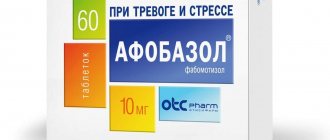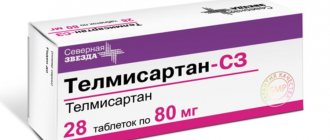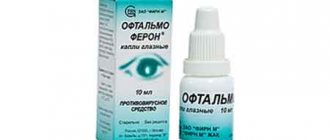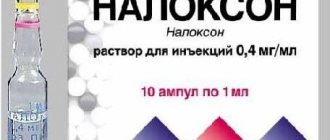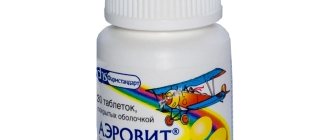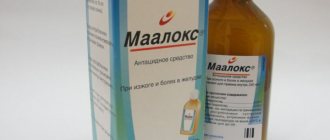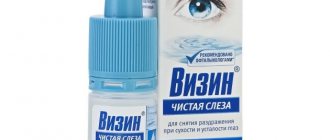- May 28, 2020
- Neurology
- Ulyana Romanova
The drug "Spazmalin", the instructions for use of which will be studied in this article, is a fairly common antispasmodic analgesic in medical practice. For what conditions is it prescribed? Are there any contraindications? Are there any side effects? There are many questions, and you will find out the answers to the most important ones below.
Pharmacodynamics and pharmacokinetics
This drug is a combined antispasmodic analgesic , with an effect due to its constituent components.
Metamizole sodium is a derivative of Pyrazolone, a well-known analgesic -antipyretic , which has a significant analgesic, antipyretic and weak anti-inflammatory effect, which is associated with inhibition of prostaglandin production.
Fenpiverinium bromide is an m-anticholinergic blocker , which has an additional antispasmodic effect on smooth muscles.
Pitophenone is a myotropic antispasmodic that has a direct effect directly on the smooth muscles of all internal organs, promoting its relaxation.
Information on the pharmacokinetics of this drug is not provided.
Solution for injection Spasmalin
Instructions for medical use of the drug
Description of pharmacological action
A combined analgesic and antispasmodic agent, the combination of drug components leads to a mutual enhancement of their pharmacological action. Metamizole sodium is a pyrazolone derivative that has an analgesic and antipyretic effect. Pitophenone hydrochloride has a direct myotropic effect on smooth muscles (papaverine-like effect). Phenpiverinium bromide has an m-anticholinergic effect and has an additional myotropic effect on smooth muscles.
Indications for use
Pain syndrome (mild or moderate) with spasms of smooth muscles of internal organs: renal colic, spasm of the ureter and bladder; biliary colic, intestinal colic; biliary dyskinesia, postcholecystectomy syndrome, chronic colitis; algodismenorrhea, diseases of the pelvic organs. For short-term treatment: arthralgia, myalgia, neuralgia, sciatica. As an auxiliary drug: pain syndrome after surgical interventions and diagnostic procedures.
Release form
injection; glass ampoule, blister 5, cardboard box 5. solution for injection; glass ampoule, blister 5, cardboard box 1.
Contraindications for use
Hypersensitivity (including to pyrazolone derivatives), inhibition of bone marrow hematopoiesis, severe liver and/or renal failure, glucose-6-phosphate dehydrogenase deficiency, tachyarrhythmias, severe angina pectoris, decompensated CHF, angle-closure glaucoma, prostatic hyperplasia (with clinical manifestations) , intestinal obstruction, megacolon, collapse, pregnancy (especially in the first trimester and the last 6 weeks), lactation. For intravenous administration - infancy (up to 3 months) or body weight less than 5 kg. For tablets - children's age (up to 5 years). With caution. Renal/liver failure, bronchial asthma triad, tendency to arterial hypotension, hypersensitivity to other NSAIDs.
Side effects
Allergic reactions: urticaria (including on the conjunctiva and mucous membranes of the nasopharynx), angioedema, in rare cases - malignant exudative erythema (Stevens-Johnson syndrome), toxic epidermal necrolysis (Lyell's syndrome), bronchospastic syndrome, anaphylactic shock. From the urinary system: impaired renal function, oliguria, anuria, proteinuria, interstitial nephritis, red staining of urine. From the cardiovascular system: decreased blood pressure. From the hematopoietic organs: thrombocytopenia, leukopenia, agranulocytosis (may be manifested by the following symptoms: unmotivated rise in temperature, chills, sore throat, difficulty swallowing, stomatitis, as well as the development of vaginitis or proctitis). Anticholinergic effects: dry mouth, decreased sweating, accommodation paresis, tachycardia, difficulty urinating. Local reactions: with intramuscular injection, infiltrates at the injection site are possible. Overdose. Symptoms: vomiting, decreased blood pressure, drowsiness, confusion, nausea, pain in the epigastric region, impaired liver and kidney function, convulsions. Treatment: gastric lavage, administration of activated carbon, symptomatic therapy.
Directions for use and doses
IV, slowly, usually 2 ml of the drug is enough. 2-5 ml of solution is administered intramuscularly 2-3 times a day. The daily dose should not exceed 10 ml. The duration of treatment is no more than 5 days. The drug is prescribed intramuscularly or intravenously to children depending on age in the following single doses: 3–11 months - 0.1 ml; 1–4 years - 0.2 ml; 5–7 years - 0.4 ml; 8–11 years – 0.5 ml; 12–14 years old - 0.8 ml. If necessary, repeated administration of the drug in the same doses may be prescribed. The solution is incompatible in the same syringe with other medications.
Interactions with other drugs
The solution for injection is pharmaceutically incompatible with other drugs. When administered together with H1-histamine blockers, butyrophenones, phenothiazines, tricyclic antidepressants, amantadine and quinidine, the m-anticholinergic effect may be enhanced. Enhances the effects of ethanol; simultaneous use with chlorpromazine or other phenothiazine derivatives can lead to the development of severe hyperthermia. Tricyclic antidepressants, oral contraceptives and allopurinol increase the toxicity of the drug. Phenylbutazone, barbiturates and other hepatoinducers, when administered simultaneously, reduce the effectiveness of metamizole sodium. Sedative and anxiolytic drugs (tranquilizers) enhance the analgesic effect of metamizole sodium. Radiocontrast drugs, colloidal blood substitutes and penicillin should not be used during treatment with drugs containing metamizole sodium. With simultaneous administration of cyclosporine, the concentration of the latter in the blood decreases. Metamizole sodium, displacing oral hypoglycemic drugs, indirect anticoagulants, corticosteroids and indomethacin from protein binding, can increase the severity of their action. Thiamazole and cytostatics increase the risk of developing leukopenia. The effect is enhanced by codeine, H2-histamine receptor blockers and propranolol (slows down the inactivation of metamizole sodium).
Special instructions for use
During treatment with the drug, it is not recommended to take ethanol. With long-term (more than a week) treatment, monitoring of the peripheral blood picture and the functional state of the liver is necessary. If agranulocytosis is suspected or thrombocytopenia is present, the drug should be discontinued. It is not permissible to use it to relieve acute abdominal pain (until the cause is determined). Use in nursing mothers requires cessation of breastfeeding. Intolerance is very rare, but the risk of developing anaphylactic shock after intravenous administration of the drug is relatively higher than after taking the drug orally. Patients with atopic bronchial asthma and hay fever have an increased risk of developing allergic reactions. Parenteral administration should be used only in cases where oral administration is not possible (or absorption from the gastrointestinal tract is impaired). Special caution is required when administering more than 2 ml of solution (risk of a sharp decrease in blood pressure). The IV injection should be carried out slowly, in the “lying” position and under the control of blood pressure, heart rate and respiratory rate. When treating children under 5 years of age and patients receiving cytostatic drugs, metamizole sodium should only be taken under medical supervision. For intramuscular administration it is necessary to use a long needle. It is possible that the urine may turn red due to the release of a metabolite (it has no clinical significance). During treatment, drivers of vehicles and persons engaged in potentially hazardous activities that require quick physical and mental reactions should be careful.
Storage conditions
In a place protected from light, at a temperature not exceeding 30 °C.
Best before date
36 months
ATX classification:
N Nervous system
N02 Analgesics
N02B Analgesics and antipyretics
N02BB Pyrazolones
N02BB52 Metamizole sodium in combination with other drugs (excluding psycholeptics)
Indications for use of Spazmalin
The main indications for use are:
- pain syndromes due to spasms of smooth muscles inside the body, for example, with renal or biliary colic , algodismenorrhea ;
- carrying out short-term symptomatic therapy for neuralgia, arthralgia, myalgia , and so on.
Spasmalin injections are also used as an adjuvant to reduce pain after surgical or diagnostic procedures.
The tablets are often taken for headaches or migraines .
Contraindications for use
It is recommended not to use the drug if:
- granulocytopenia;
- diseases of the hematopoietic system;
- severe dysfunction of the liver and kidneys;
- angle-closure glaucoma;
- deficiency of glucose-6-phosphate dehydrogenase;
- tachyarrhythmias;
- benign prostatic hyperplasia;
- lactation, pregnancy;
- children less than 3 months old and weighing up to 5 kg, and so on.
special instructions
Impact on the ability to drive vehicles and operate machinery
During therapy with Spasmalin, it is recommended to exclude potentially dangerous activities associated with driving a car and operating complex machinery. Some side conditions can negatively affect the speed of psychomotor reactions and the ability to concentrate.
Pregnancy and lactation
Spasmalin is not recommended for use during pregnancy. The first trimester is an absolute contraindication. At this stage of fetal development, substances contained in the drug may cause harm. During the lactation period, the use of antispasmodics is permitted only with the temporary exclusion of breastfeeding.
Use in childhood
In pediatrics, Spazmalin is used to treat children from three months. For young patients, a special dosage regimen is required. Violating the recommendations of the instructions will increase the risk of side symptoms.
For kidney problems
Kidney dysfunction is noted by the manufacturer in the list of contraindications for taking Spazmalin. For mild pathological processes, the use of the medication is permissible, but under the supervision of a physician and with adjustment of the dosage regimen.
For liver disorders
In the list of contraindications for the use of Spazmalin, the manufacturer notes severe liver dysfunction and liver failure. In some cases, the use of the drug is acceptable, but with adjustment of the dosage regimen.
Conditions for dispensing from pharmacies
Spasmalin is sold by prescription.
Side effects
When treated with Spasmalin, side effects may occur that affect the functioning of the digestive, cardiovascular, nervous, excretory and hematopoietic systems. The most common symptoms are: dry mouth, discomfort in the gastrointestinal tract, decreased blood pressure, cyanosis, tachycardia, thrombocytopenia, leukopenia , dizziness , impaired renal function, and so on.
Allergic reactions in the form of itching are possible .
Spasmalin, instructions for use (Method and dosage)
The tablets are taken orally, preferably after meals. For adults and children over 15 years of age, a daily dosage of 1-2 tablets is prescribed for 2-3 times a day. At the same time, taking more than 6 tablets per day is not allowed. You can take the tablets for no more than 5 days.
If you need to increase the dose or duration of treatment, then medical supervision is necessary. Treatment of children is possible only as prescribed by a specialist. The average dose for young patients 6-8 years old is ½ tablet, 9-12 years old – three-quarters of a tablet, and children 13-15 years old can take one tablet 2-3 times a day. Dosage changes can only be made by the attending physician.
The drug solution is used for intravenous or intramuscular administration. Injection into a vein is performed slowly, using no more than 2 ml of the drug. When administered into a muscle, 2-5 ml of the drug is prescribed for 2-3 times a day.
It should be noted that the daily dose cannot be more than 2 ampoules. The average duration of therapy is 5 days.
Mixing Spazmalin solution and any other medicine in one syringe is not allowed.
Shelf life
Under no circumstances should children have access to the drug. Spazmalin should be stored in a dark place where it is dry and warm.
If these conditions are met, Spazmalin can be stored for 3 years. After the expiration date, the product should be discarded.
Interaction
The combination of Spazmalin with some non-opioid analgesics can cause mutually enhanced effects.
Simultaneous use of tricyclic antidepressants, oral contraceptives, Allopurinol disrupts the metabolism of metamizole sodium, significantly increasing its toxicity.
Combinations with barbiturates, phenylbutazone and other inducers of microsomal enzymes may weaken the effectiveness of metamizole sodium.
The drug also reduces the concentration of Cyclosporine in the blood plasma .
Tranquilizers and sedatives often enhance the analgesic effect of Spazmalin.
Simultaneous use with histamine H1 receptor blockers, phenothiazines, butyrophenones, Quinidine and Amantadine enhances the m-cholinolytic effect of these drugs.
Alternative drugs
It’s worth finishing the topic with a discussion of analogues of “Spazmalin”. Their instructions for use are exactly the same, since they contain the same active ingredients. And here are the medications we are talking about:
- "Maxigan."
- “I took it.”
- "Spasmopharm".
- "Spazgan".
- "Plenalgin".
- "Revalgin."
- "Spasmoblock".
- "Trinalgin."
- "Baralgetas".
- "Bralangin."
- "Spazmalgon."
- "Spasmaton."
- "Renalgan".
- "Geomag."
In addition to the listed remedies, there are many more medications with a similar effect, but with other active ingredients in the composition. Among the most famous are:
- "Tempalgin".
- "Sedal-M".
- "Andipal Avexima."
- "Analgin."
- "Baralgin M".
- "Pentalgin-N".
- "Sedalgin Plus"
- Unispaz.
- "Novigan".
- "Andipal".
- "Migrenol."
- "Upsarin UPSA."
- "Pentalgin".
And this is only a small part of the existing substitutes for “Spazmalin” in ampoules and tablets. However, you need to remember that in no case should you choose your own medicine, since any medicine, even one that seems like a harmless painkiller, has contraindications and can cause side effects.
Analogs
Level 4 ATC code matches:
Antipyrine
Analdim
Reopirin
Tempalgin
Benalgin
Pentalgin ICN
Pentalgin N
Pentalgin
Analgin
Tetralgin
Maxigan
Sedal-M
Piralgin
Baralgin M
Sedalgin Plus
Revalgin
Andipal
The main analogues: Baralgetas, Bral, Renalgan, Spazgan, Spazmalgon, Spazmil-M, Spazmoblok, Spazmogard and Trinalgin.
Reviews of Spasmaline
It should be noted that reviews of Spazmaline are not common on the Internet. Some users are completely unfamiliar with this drug and usually use its analogue, Spazmalgon, which also has an antispasmodic effect.
Also on medical forums you can find messages from users who are interested in what Spazmalin helps with, although many people understand its action based on the name.
However, everyone who has used this drug notes that it helps especially well in relieving menstrual pain , as well as pain in diseases of the genitourinary system, for example, cystitis . Usually, taking just 2 tablets helps relieve the condition and eliminate pain. At the same time, women talk about its good tolerance, that is, no side effects appeared.
As for experts, they recommend not to abuse any means that have an antispasmodic effect. The fact is that, despite their high effectiveness, when used regularly to relieve pain, this medicine can have a negative effect on the body. Moreover, as a result of relieving pain syndromes, the development of a serious disease may not be detected in a timely manner. Therefore, drugs with similar effects should be used only as prescribed by a doctor.
What do people say?
Above, the instructions for using “Spazmalin” were studied in detail. Reviews are what else you need to pay attention to. Comments from real people always help to understand whether the medicine is really as effective as it is made out to be.
And judging by the reviews, the Spazmalin solution and tablets are a real panacea for neuralgia, menstrual syndrome, as well as muscle, toothache and headaches.
For severe syndromes, injections help, but for moderate ones, pills are enough. The tablet begins to act within 10-15 minutes, and after 20 minutes the person completely forgets about the sensations that were bothering him. If you believe the reviews, then this drug can even relieve pain resulting from a severe attack - when it becomes difficult to even think and turn your head.
Plus, the medicine has a relatively low price. About 170 rubles for a package of 20 good painkillers is not much.
Spazmalin price, where to buy
The drug in ampoules of 5 ml for 5 pieces can be purchased at a price of 105 rubles.
The medicine in tablets for 20 pieces costs from 127 rubles.
- Online pharmacies in RussiaRussia
ZdravCity
- Spasmaline tablets 100 pcs.Torrent Pharmaceuticals Ltd
456 rub.order

